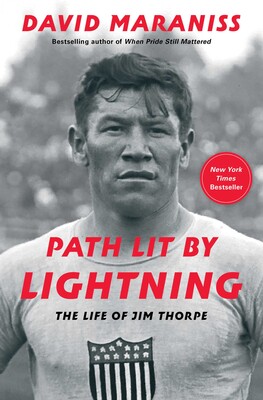Path Lit by Lightning: The Life of Jim Thorpe
- By David Maraniss
- Simon & Schuster
- 672 pp.
- Reviewed by James A. Percoco
- January 2, 2023
A magisterial biography of America’s greatest athlete.

The term GOAT (Greatest Of All Time) is often bandied about in discussions of athletes like Tom Brady, Tiger Woods, and Serena Williams. But before that term was even coined, there reigned the original GOAT: Jim Thorpe. In the compelling Path Lit by Lightning, Pulitzer Prize-winning biographer David Maraniss gives us a solid examination of Thorpe the man while peeling back the layers of Thorpe the myth.
Born in 1887 in the Indian Territory of what would eventually become Oklahoma, Thorpe was a member of the Sac and Fox nation. At 16, and soon to be orphaned, he was sent to the Carlisle Indian Industrial School in Pennsylvania, whose program of assimilation embraced the popular “Kill the Indian, and save the man” ethos of the time. Misguided at best, and cruel at worst, it was white America’s way of dealing with the “Indian problem.”
At Carlisle, as at other such schools, students had Indian culture drilled out of them and white culture drilled in. (Ironically, the city of Carlisle today owes its name recognition largely to its famous Indian son.) While at Carlisle, Thorpe excelled at football and track and field. Under the tutelage of Glenn “Pop” Warner, he led the Carlisle football team to national prominence during the 1911 and 1912 seasons.
People flocked to the small Pennsylvania town to watch Thorpe and his Indian teammates take on rivals like Yale, Harvard, and Army with unmatched athletic prowess. Thorpe was soon named an All-American (and, in 1963, would be inducted posthumously as a charter member of the National Football Hall of Fame in Canton, Ohio).
Thorpe was also a star at the 1912 Olympics in Stockholm, where, as part of the U.S. team, he won gold medals in both the pentathlon and decathlon. As Sweden’s King Gustavus presented the honors to Thorpe, he remarked, “You sir, are the most wonderful athlete in the world.” Thorpe returned home a hero, and to those who endorsed Indian boarding schools, a shining example of what the facilities could do.
But glory would not last long for Thorpe. Prior to the Olympics, he’d played two seasons of minor-league baseball in North Carolina, for which he was paid a paltry sum. According to the Amateur Athletic Union, which dictated the terms of eligibility for the Olympics, this meant Thorpe was not, in fact, an amateur. He was retroactively ruled ineligible to compete at the Olympics, and his medals were stripped.
Former supporters, including Pop Warner, abandoned Thorpe under the pretext of not knowing about his quasi (at best) professional status. It was the worst kind of duplicity; everyone had of course known about Thorpe’s participation in the minors. Publicly, Thorpe brushed off the humiliation; privately, he was crushed.
In the years that followed, which Maraniss chronicles with empathy, Thorpe strove to build a sports career. He played professional baseball for the New York Giants and pro football for the Canton Bulldogs. His athletic feats continued to draw crowds eager to see the “big Injun” perform. Yet his peripatetic existence cost him two marriages, both of which ended in divorce, and led him to alcoholism. The loss of his Olympic titles continued to haunt him.
Thorpe was one of the first Americans to garner celebrity status in an age of changing media, although fame dogged him, too. He was often expected to embody “the Indian” wherever he went and in whatever he did. He played bit parts — as an Indian extra — in several Westerns, but when Hollywood released the biopic “Jim Thorpe – All-American” in 1951, he served as a mere advisor to Burt Lancaster, the Caucasian actor portraying him. Maraniss is justly critical of the film, which embraces the white-savior trope by being told not through Thorpe’s eyes, but through Warner’s.
Thorpe never managed to outrun the myth that had been built around him by sportswriters like Grantland Rice and others, nor could he escape being pigeonholed as a stereotype and treated as a commodity. Everything he did — good or bad — somehow seemed to make for good copy. Yet he persisted. In 1950, Thorpe was named by the Associated Press as one of the greatest athletes of the first half of the 20th century.
“Lo, the poor Indian!” wrote 18th-century English poet Alexander Pope, “whose untutor’d mind Sees God in clouds, or hears him in the wind.” Thorpe endured that racist mindset — that Indians were to be pitied as lesser creatures who could only be saved by the Great White Father — yet didn’t surrender to it. He died in 1953. The International Olympic Committee reinstated his awards in 1983, presenting his children with replicas of the medals he’d been forced to surrender. Today, in 2023, Thorpe remains the Greatest of All Time.
“Thorpe’s unparalleled athletic accomplishments did not make his life triumphant,” writes Maraniss in the book’s preface. “His days were marked by loss…There is a temptation, then, to view his story as tragedy, but I emerged from my study of his life with a different interpretation…For all his troubles, whether caused by outside forces or of his own doing, Jim Thorpe did not succumb. He did not vanish into whiteness. The man survived, complications and all, and so did the myth.”
James A. Percoco is history chair at Loudoun School for Advanced Studies in Ashburn, Virginia, and the author of Summers with Lincoln: Looking for the Man in the Monuments. A member of the National Teachers Hall of Fame, his current book project is Final Words: Discovering America’s Literary Legacy in the Nation’s Graveyards.
